Panasonic KX-PX20 Compact Photo Printer Review
Read a review of the Panasonic KX-PX20 compact photo printer.
Products are chosen independently by our editors. Purchases made through our links may earn us a commission.
Setup/Drivers and Software
Out of the box* (7.00)*The Panasonic PX-20 comes with the basic equipment, including the paper cassette, power cord, AC adapter, starter kit (ink cassette for five prints and five sheets of postcard paper), installation CD, quick start guide in Spanish only, and paper manual. Also included is a video cable and remote control.

Setup* (8.00)*The KX-20 sets up in less than ten minutes, including the software installation. The process is simple, and prints can be made from memory cards within 5 minutes of taking it out of the box. Once all the tape is taken off, the user needs to fill and attach the paper cartridge. These devices tend to be delicate and need to be attached just so. The Panasonic cartridge is better constructed than others, notably the Canon Selphy print cartridges. The ink cartridge is a much simpler affair to install. Just open the door on the right, then slide it in. It locks in place and the door can be closed. Printing can begin. **Manual/Quick Start Guide*** (6.50)*The quick start guide is only available in Spanish, while the Operating Instructions are only available in English. Both are illustrated with diagrams and screen shots. The Operating Instructions provide enough information for the user to reference as a guide to printing or troubleshooting. **Drivers and Administration*** (6.50)*The printer driver for the PX20 includes three tabs. The Basic Settings tab has a status window on the left that displays a graphic showing the printable area of the paper and what portion of the image will be cropped, if any. Below this is a list of all the possible settings and image adjustments possible in the driver and their current settings. On the right side of the Basic Settings tab are the choices for page size, printer paper size, orientation, number of copies, and borders.
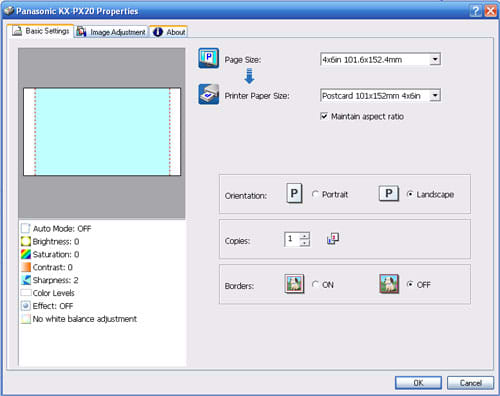
The Image Adjustment tab provides the user with options for adjusting the image using an Auto Mode feature, with selections for Off (no Auto adjustment), Auto, Soft Skin, Indoor, Vividness, and Night Scenery. A preview window on the left displays two versions of the same sample fruit stand image. The lower version displays an example of any change in settings. Manual adjustments for Density and Balance are found in the box to the right, with settings for brightness, saturation, contrast, and sharpness possible. A color grid shows to the right, and users can select a particular color square to adjust the color of the image in that direction.

The Effect drop-down box below density/balance and color grid gives options for changing the image to a monochromatic color scheme of warm, cool, or sepia. Other effects include cool or warm color palette, soft portrait embossed heart, and concave and convex spheres. A Show Preview box allows users to select viewing of previews for the first page or all pages. The About tab displays information about the printer and the driver versions.
Software* (0)*The KX-PX20 ships with no software. Any computer printing needs to be conducted with existing software programs on the host computer.
Photo Performance
General **performance**Warm*-up**(5.89)*Warm-up time for the PX20 of 14 seconds yielded a moderate score compared to all printers tested, but it scored lowest of all compact printers tested. The other two dye sub printers tested, the Canon CP730 and the Sony FP90, came up to ready status in 11 and 7 seconds, respectively. Power Usage (5.83)
The PX20 also scored the lowest in our power usage test. We use a watt meter to test the watts used by the printer in various modes, including off, ready, idle, and printing. While it did use less average watts while printing than the CP730 and the FP90, the Panasonic PX20 used more power while off and in ready mode than the other two compact dye sub printers. This brought its score down lower.
**Photo Speed/Timing*** (3.66)*
Because the dye sublimation printing process requires four passes of the paper through the paper path to lay down the three colors plus the clear overcoat, printing speeds are slower than most inkjet and laser printers. The Panasonic PX20 prints even slower than many other dye subs and all of the dye subs we’ve tested, especially when printing from memory cards. The PX20 produced only about half a page per minute (around 2 minutes per page) for both small (6 mb) and large (19 mb) file sizes.
Compared to two compact inkjet printers that have come through our labs, the PX20 scored in the middle. It was much slower than the Epson PM240 and slightly faster than the HP A440. **Color Accuracy*** (2.15)*Dye sub printers are not known for their color accuracy. Their color reproduction is limited. This is reflected in the scores of our color accuracy test, which we perform using a digital version of the Gretag Macbeth Colorchecker chart, devised for us by Bror Hultgren of Image Integration. The chart is a grid of standardized color patches representing often photographed colors and tones, including skin tones, shy blue, foliage green, and a six-step tonal scale of white to gray. An example of this chart is displayed below.
We print the digital Colorchecker chart out using the test printer, and then we read the color values (a coordinate value of where the color falls within a given color space) using our spectrophotometer. These La**b** values, as they are known, are compared to the actual values of the color patches. The difference between the printed chart’s values and the actual values results in a color error for each patch. The average error is what we base our color accuracy score on. The Panasonic KX-PX20 scored a very low 2.18, representing a mean color error of 10.01, the second highest color error of any printer yet tested, second only to a laser printer. The Canon CP730 and the Sony FP90 scored close to this, but both had a lower error value—8.61 and 9.75, respectively. The individual error values usually give an indication that a printer’s representation of colors is skewed toward or away from a certain side of the color spectrum. Often greens or yellows are consistently off. In the case of the PX20, there seems to be no set pattern. For example, blue had one of the largest error values of about 15, while cyan had one of the lowest error values, at just over 2. White had a low error value, while the other gray tones had much larger errors. Dark skin tones also showed a large error value. Most values were at least above 9. We also printed the chart using a custom-made profile (using the EyeOnePro), and this showed much less color error, only 5.72. The greatest error showed in the greens, most notably green and bluish green. The lowest error values showed in the gray scale. Skin tones also had low error values. However, since most users of this printer will not be creating their own profiles, this printer is scored based on the default settings. The custom profile illustrates that this printer is capable of greater color accuracy than is possible using the default settings. **Color Gamut***(1.74)*Color gamut is the range of colors that a printer is capable of reproducing. We measure this value using Gamutvision, which graphically displays the printer’s color profiles in comparison to an existing standard. We use Adobe RGB, a color space that is well beyond what most compact printers are able to reproduce. However, since we at Printerinfo test the whole range of printers from these compact models through high-end, wide format printers, it’s more appropriate to use the more commonly used Adobe RGB standard.
Gamutvision also displays the numeric value for these profiles, based on the number of colors the printer can reproduce. The Adobe RGB space displays a constant 1,225,088 colors. High-end photo printers can produce within the 60th percentile of colors, while most mid-range printers lie within the 40th to 50th percentiles. Other compact photo printers tested, including the Canon CP730 and Sony FP90 dye sub printers, scored in the low 40th percentile.
Since no profiles were provided with Panasonic PX20 compact photo printer, we created our own using Gretag Macbeth’s color profiling equipment: the Eye-One Pro spectrophotometer and the Eye-One Match software. We do this for every printer we test and compare the gamuts for each profile. The PX20 yielded only 29 percent of the Adobe RGB space, a very poor showing. The chart below shows the AdobeRGB color space as the wire frame and the PX20 custom color profile as the solid color form in the center. The PX20 profile is lacking in every respect, falling far short in every color except whites and very light yellows and pinks.

Dmax*(2.96)*Another measure of print quality is the density of the black tones that the printer is capable of printing. The deeper the black, the potentially wider tonal range the printer can reproduce. The ideal standard value for a very rich, deep black is 2.50. This vale is known as Dmax. Many high-end photo printers can usually attain a Dmax value around 2.30. Unfortunately, the Panasonic PX20’s Dmax value was one of the poorest we’ve seen—1.56. The other dye sub printer’s we’ve tested scored much higher. The Canon CP730 achieved a Dmax of 2.01, while the Sony FP90 produced an impressive 2.30, very high for a compact photo printer. The PX20’s score was somewhat comparable to a low-end inkjet printer by HP, the A440, which produced a Dmax of only 1.71. **Monochrome***(4.00)*The PX20’s low Dmax score is certainly a reflection of its black-and-white printing performance. Our test print showed a very washed out and muddy print, with very limited definition and contrast, and a poor tonal range. The blacks clearly do not pop as much as is seen in the original image or prints made with other printers, leaving the print with a washed-out appearance. We would have liked to show a scan of the print here to illustrate our point, but unfortunately, the scan degraded the quality of the image enough to make a valid comparison to the original unfair.
Tour/Components
Tour*Front*With the paper cassette door and folding LCD screen closed, the front of the PX-20 is a simple silver rectangle. The top edge of the screen is visible at the top of the front. Only a few small features are visible on the printer’s front. A small, rectangular piece of frosted plastic on the left covers the remote control receiver. Below this is the PictBridge logo, indicating that the port for the camera connection lies directly behind this. The slender, rectangular paper cassette compartment cover sits along the bottom of the front, with a finger slot in the top center to allow for opening. Along the top right and left edges of the door are a set of six raised dots to indicate where the user should push to lock the door back in place after closing. With the LCD screen opened, the dark gray, rectangular housing surrounding the screen can be seen, and, with the printer turned off, just the black screen can be seen inset into the housing. The Panasonic logo sits below this.
*Back*The most obvious features visible on the back of the PX-20 are the heat vents, three sections of dots along the left and center. The AC port is on the left, and the Video Out port and the USB port lie to the right.

*Left Side*The left side contains no functional features but is merely shows a rectangle of dark gray plastic, which is part of the lower chassis, and the silver part of the upper chassis.

*Right Side*Similar in design to the left side, the right side contains the all-important ink cassette door, opened by a finger slot in the top center of the door.

*Top*With the display door closed, the printer shows the Panasonic KX20 logo in the center of the door. To the left of the door lies the Power button and indicator light. Along the bottom, the Error, Access, and Print lights can be seen. The SDHC logo lies at the upper right, above the actual slot itself, which sits behind the ink cassette compartment cover at the upper right. With the LCD door opened, the control panel beneath can be seen. The panel’s buttons are arranged in a line, with the Display and Menu buttons on the right. (These also function as the Trimming controls.) The four-way navigation dial and the central OK button sit in the center of the panel. To the right of this sits the Return and the large, lighted Print button, which also doubles as the Rotate control.

*Interior*With the paper cassette compartment cover open, the input/output paper path can be seen, including the rollers and paper cassette connection. Also visible to the left is the PictBridge camera connection, with the PictBridge name embossed into the plastic alongside. With the ink cassette removed, the rollers for the cassette can be seen inside the printer.

*Display (9.00)*The PX20 comes with a large, 3.6" LCD screen, a great feature for a portable printer. This is bigger than most all-in-one inkjet printer displays on the market. The resolution is very good, with 230,000 pixels and an angle of view of nearly 180 degrees. The screen folds down into a well in the body of the printer, thus protecting the screen when not in use.
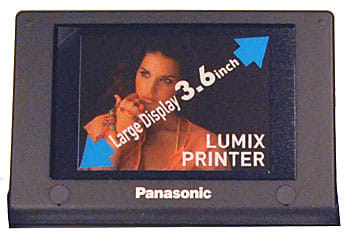
*Paper Trays (6.50)*As with most dye sublimation printers, the PX20 has a single paper tray that serves as both the input and output tray. The tray is a two part detachable cassette that normal postcard-sized paper fits snugly into. A rigid plastic flap holds the smaller paper in place but folds down easily for use with 4"x7" paper.
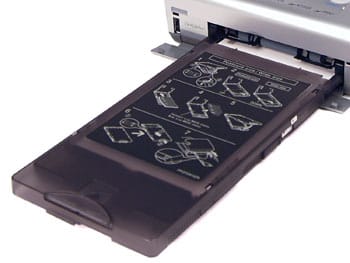
The tray, like most of these, is a little awkward to fit together and operate. The They all hinge at the back end and you have to squeeze the front sides to release the top when it’s in the closed position. The top needs to be slid back about 1.5" until it clicks before it can be inserted into the paper path in the front of the printer. *

Power supply *The PX20 comes with a power cord and an AC power adapter. *Battery (0)*The PX20 comes with no battery, nor the option to purchase one. *Internal Memory (0)*The PX20 has no internal memory to speak of. Images are stored on the memory cards or on a computer. *Multi-Tasking (0)*This compact, single-use, photo printer can only perform one function at a time. *Hard drive (0)*The PX20 has no hard drive to store images or other data. *CD Burner (0)*Very few compact photo printers come with a CD burner, and the PX20 is not among them. *Accessories (6.00)*Panasonic provides a video capable for hooking the printer up to a television allowing the user to print from the TV monitor. Optional accessories available on Panasonic’s website include SD cards and paper supplies. Paper packs are available in 36-sheet and 108-sheet packs for $24.95 and $49.95, respectively. A 50-sheet paper and ink pack is available for $49.95. Special paper for printing 16:9 aspect ratio images is available in a 20-pack box for $29.95. However, the user also needs to purchase the special wide paper cassette for $9.95 in order to print with this paper. Stickers and adhesive paper are also available.
Design/Interface
Controls/Buttons/Dials* (8.00)*The Panasonic PX20 has a very simple control panel, with just six buttons. Most of these sit in the well below the display screen, which, when folded down, hides all them. The power button sits along the left edge of printer, outside this well. A small LED sits above the button to indicate when its on or off. A red light shines when the unit is plugged in and off, while a green button shines when the unit is on.

The Display and Menu buttons sit to the far left of the panel. The Display button switches the view from thumbnails to single image display, and the Menu brings up the printer’s menu options. These button also zoom out and in, respectively, allowing for image trimming. Dead center is the combination OK/Navigation button, with the four-way control surrounding the OK button, as in many printers and cameras. The Return button to the right allows the user to exit from the current menu screen to the previous one. The large white Print button sits at the far right and also serves as the Rotate button to realign the image’s orientation. An additional remote control is included with the PX20; this is not featured with any other compact printers to date. It includes all the basic controls that the control panel features—Power, Print, OK and navigation buttons, Menu, Return, and Display—but it also features separate Trimming and Rotate buttons, as well as separate Slide Show and Search buttons. While the PX20 does have a large screen, it’s hard to imagine being far enough away to use the remote control and still be able to see the images. **Menus *(6.50)*The PX20’s menu design is fairly rudimentary, with simple graphics, plain text, and an ugly turquoise background. The main screen displays the images on the SD card (if that’s installed). Pressing the Menu button brings up four main options. The choices are laid out well, with the menu design showing both the main options and the currently selected choice for that option. Panasonic KX-PX20 Menus Size / Footprint*** (8.36)*Just by virtue of being of being a compact photo printer, the Panasonic PX20 gets a high score. These printers do indeed take up very little desk space, although it is more than advertised because the manufacturer’s specifications don’t take into account the paper cassette, which needs to be attached anytime the printer is operating. The PX20 scored about the same as the Sony FP90, which has the same size LCD screen, also a flip-up. The Canon CP730 scored higher than both of these similar-sized models because its LCD screen is recessed into the printer. This gives it a higher size score, but the LCD screen is much less usable.
Inks / Toner
**Configuration ***(8.00)*The ink cartridges on compact dye sublimation photo printers like the Panasonic PX20 are one of the simplest configurations possible, with a single cassette providing all three colors and the overcoat layer. These cartridges are virtually the same for all printers, although the exact design is specific to each manufacturer. While dye sub printers may not produce the best looking prints, they do provide the user with easy cartridge loading and no messy inks. The dyes are affixed on the thin roll of film within the cassette. A section of film equivalent to the size of the print is used for each color. Heated rollers allow the dye to be transferred to the paper based on the image information communicated from the memory card or computer.
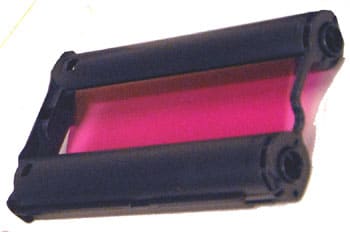
**Value*** (2.00)*Based on Panasonic’s prices on their website, a 108-sheet print pack (paper and ink sold together) costs $49.95. This breaks down to 46 cents a print, much higher than the competitiors. This is especially true when comparing the cost to other dye sub printers like the Canon Selphy CP730, for which ink and paper sets can be purchased with 108 sheets for $29.99. That breaks down to 28 cents a print. Sony sells 120-sheet paper and ink packs for its PictureStation DPP-FP90 for $34.99, which comes out to 29 cents a print. Note when purchasing ink sets from the Panasonic website that the 108-sheet, 36-sheet, and 20-sheet packs (KX-PVMS108KM, KX-PVMS36KM, and KX-PVMS20WM, respectively) do not indicate that they are sold with the ink cassettes. However, they are, according to the information found in the Operating Instructions. **Toner management***(2.00) *There is no tool available to manage ink levels, other than a warning on the printer’s screen when the ink runs out that a new cassette needs to be loaded. Users can only judge by the amount of paper they have left, since Panasonic, like other dye sub printer manufacturers, sell their paper and ink in print packs.
Print Settings/Options
Print Quality Settings* (0)*Like other compact printers, print quality remains constant for the Panasonic PX20. In the case of dye sub printers, quality is usually fixed at 300 x 300 dpi. Neither the driver nor the unit’s menu provide options for quality settings. **Internal Editing*** (6.00)*Users can select between Auto mode or adjust density/balance, color levels, or white balance themselves in the Image Adjustment menu. Effects can also be applied to the images, including monochrome effects (see below), Warm, Cool, Soft Portrait, Embossed Heart, Oil Painting, Japanese Paper, Convex Sphere, and Concave Sphere. Many of these are cheesy but appropriate to a simple printer like this. These changes are only viewable on the stock image included in the menu. Users can only see how the filter applies to their image after printing it out. Users can also create calendars and composite images with the PX20. There is also a whole gallery of clip art, including generic cartoony characters and text greetings in multiple languages.

**Dedicated B&W Settings / Effects*** (5.00)*Panasonic PX20 users can choose between the basic selections of monochrome settings, including warm monochrome, cool monochrome, and sepia. It’s standard to have these options, but it would be nice to see more color options for those craftily inclined.

Media Types* (5.00)*Paper types for the PX20 are mostly limited to basic postcard paper or wide paper for printing 16:9 aspect ratio pictures. Stickers and adhesive paper can also be purchased.
Connectivity
Formats/Compatibility*(6.00)*The PX20 is designed to work with Panasonic’s LUMIX line of cameras via the PictBridge port behind the paper cassette door. Other PictBridge-enabled cameras can also be hooked up to the PX20. The printyer has one USB port for hooking the printer up to a computer. There is also a video port for prinitng images from a television.
**Media Slots***(3.00)*The PX20 is limited in its media compatibility, with only a slot for SD cards. Most other compact printers have at least a slot for CompactFlash cards. However, Panasonic only uses SD cards for its cameras, and the PX printers are meant to be used with LUMIX cameras, so the choice is not surprising. However, this makes these printers less than useful to consumers with cameras using media cards other than SD. **Wireless Interface*** (0)*There are no options for wireless connectivity with the PX20. **Network*** (0)*No network options are provided for the PX20, as is the case with many compact printers.
Overall Impressions/Ease of Use
Ease of Use*(7.00)*The extensive menu, large LCD, and simple control panel make the Panasonic KX-PX20 a very easy compact printer to use. The menu is mostly intuitive. It’s very compact and easy to carry, although the lack of a carrying handle, as is found on the Sony FP90, is unfortunate. Unlike the Canon models, the Panasonic PX20 isn’t equipped with a battery, optional or otherwise, which would make this a truly portable and versatile printer. **Value *(2.00)*For the money, users can do much better with other compact photo printers, dye sub or inkjet. The expensive cost per print and poor image quality alone makes this a poor buy next to models such as the Sony FP90 and The Epson PictureMate Flash. But the lack of wireless compatibility, single memory card slot, and lack of optional battery go well beyond this to make the PX20 simply not worth the cost, unless the consumer is wed to Panasonic products. Comparisons**
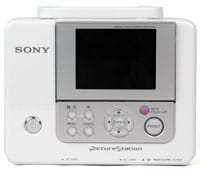
With a very similar design, the Sony DPP-FP90 beats out the Panasonic PX20 in many categories, including image quality, cost per print, and media card compatibility. The FP90 even adds a carrying handle. Menu options may be a little more limited than the on the PX20, but the FP90’s print quality is slightly better. Both printers feature a large, 3.6" LCD display, but the Sony FP90’s screen folds down face up, while the PX20’s screen folds down face down, protecting the screen.

The Epson PictureMate Flash (PM280) sells for the same price, but the infinitely better print quality and host of features puts the PX20 to shame. The PM280 boasts a resolution of 5760 x 720 dpi, as opposed to the PX20’s (and most other dye subs’) 300 x 300 dpi resolution. True, the PX20 has a large 3.6" LCD screen compared to the smaller 2.5" preview screen on the PM280, but this is a small price to pay. The PM280 features multiple media slots and wireless sensor as well as a PictBridge connection and CD/DVD drive for accessing images. The CD/DVD drive is also a burner for saving images. Users can clear their memory cards for continued shooting by saving the images to CDs.
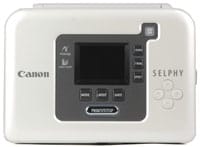
At, $149, the Canon Selphy CP730 will save consumers some money over the PX20 with little change in print quality. However, users will have to endure the very difficult to see and small LCD screen which is embedded in the printer. One area where the CP730 has the other dye subs (Sony FP90 and Panasonic PX20) beat is the optional battery. This is a feature that should be standard on these compact photo printers, but only Canon and Epson seem to get that.
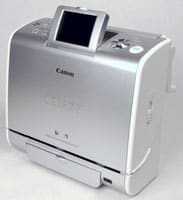
For a notch up in price, the Canon Selphy ES1, selling for $249, improves over the other models with 300 x 600 dpi resolution and an optional battery and Bluetooth adapter. It accepts multiple media cards. Its self-contained design features a paper and ink pack that are bundled together for one easy installation. There is no separate paper cassette to attach every time you need to print. Like other Canon compact printers, it comes with a carrying handle. The PX20 has it beat in just one area—the larger 3.6" LCD display compared to the ES1’s 2.5" screen.

Another dye sublimation printer for $199, the HiTi S400 presents a unique design to the compact printer market. Like the Selphy ES1, it stands upright. Unlike any other compact printer, it features a corded remote control device with an LCD screen for previewing images and viewing the menu. Where the HiTi has the other dye subs beat is in print quality, featuring 403 x 403 dpi resolution. It has an automatically opening and closing output print tray door to reduce dust. The S400 also features auto image optimization. Although it isn’t hard to do better than the Panasonic PX20’s single media card compatibility, it should be noted that the HITi S400 has slots for multiple media cards. It is alos compatible with PIctBridge and USB devices.
Conclusion
**Likes**- Large, 3.6" LCD screen.- Easy-to-use menu.- Simple, intuitive control panel. **Dislikes**- Poor image quality.- Only one media card slot (SD).- No wireless connectivity.- High cost per print. **Conclusion**The Panasonic KX-PX20 is a dye sublimation printer selling for $199. It’s comparable in size to many other dye subs, such as Canon and Sony models. The printer comes with a starter ink cassette and paper cassette good for five prints, power cord, instruction manual, installation CD, and remote control. It sets up quickly and is easy to operate. The ink cassette installs effortlessly, like most dye sub printers, and the paper cassette is better designed than others. The unit is meant to be used with Panasonic Lumix cameras, and these and other PictBridge enabled cameras can be hooked up directly to the printer to make prints. Media cards can also be used, but only SD and Multimedia cards.

The printer drivers are simple, with a few selections for image adjustment. Unlike other compact printers, the PX20 does not come with any bundled software. If printing from a computer, users will have to rely on whatever program they have. Most of the controls are in the on-unit menu. Here users can utilize auto adjustment for brightness, contrast, and color, or they can apply manual changes for these settings. Monochrome effects can be aplkied to images, as well as artsy effects, such as oil painting and Japanese paper. Also possible are adding frames and clip-art, although most of these are pretty cheesy. A calendar menu allows the user to create mini calendar pages with their own images. The PX20 performed slowly in out speed tests, but not much more slowly than other dye sub printers we’ve tested. Print quality lagged far behind its competitors in nearly very test. Very poor color accuracy was shown by the Colorchecker chart test (See the Photo Performance page), with sizable error in nearly all colors, notably skin tones. The PX20 also scored poorly in our color gamut test, meaning the range of colors it can represent is limited. Our test of the blackest tones, known as Dmax, also showed the PX20 not producing well, with very pale-looking and scoring black densities. The black-and-white prints from the PX20 were very washed out, with little contrast or definition between gray tones. The PX20 is a small boxy design, similar to other dye sub printers, like the Canon Selphy line or the new Sony DPP-FP series printers. One feature that improves upon both of its competitors’ models is that the LCD display (at 3.6 inches, it’s larger than the Canon Selphy models and equivalent to the Sony FP90), which folds face down into the body of the printer, protecting the screen when it’s not in use. The screen on the Sony FP90 also folds down, but with the screen side up. The Canon Selphy CP730 screen is embedded into the printer. The PX20 has few connectivity options, only featuring PictBridge and SD/Multimedia card connections. If consumers are wedded to dye sublimation printers, there are a few other options available, such as the Sony DPP-FP90 for the same price or the Canon Selphy CP730 for $50 less. Canon also offers a model with a different design, the Selphy ES1, for $50 more. The HiTiS400 is also available at the same price and features slightly better resolution and a unique design. For those consumers looking at both inkjet and dye sub printers, the field broadens a little with the Epson PM280. This inkjet printer features more media compatibility and connectivity options, as well as much better resolution and added features such as an included CD reader/writer and carrying handle, and an optional battery. See the Comparisons section of the Conclusion page for more info.
Specs/Ratings
Specs/Ratings**{{manufacturer_specs_table}}{{raw_scores_table}}**
